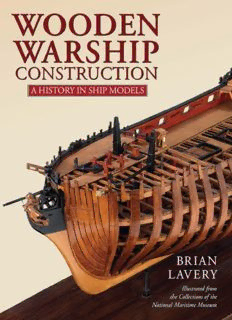
Wooden Warship Construction: A History in Ship Models PDF
Preview Wooden Warship Construction: A History in Ship Models
WOODEN WARSHIP CONSTRUCTION WOODEN WARSHIP CONSTRUCTION A HISTORY IN SHIP MODELS BRIAN LAVERY Acknowledgements We would like to thank the staff of the National Maritime Museum’s Picture Library, and especially Emma Lefley, who faultlessly organised the complicated issues surrounding the large photo orders. Other models came from the collection of the Science Museum, London, where Jasmine Rodgers was particularly helpful; thanks also to the Charles Miller Gallery. References Models in the National Maritime Museum collection are catalogued by SLR number, and in this book these are quoted at the beginning of each caption to one of these models. Further details of these models can be found on the Museum’s Collections website at: http://collections.rmg.co.uk Searching by SLR number will turn up a full description of the model and any available photographs. SLR2216 Half title: Frames of the 120-gun Caledonia. SLR2148 Frontispiece: Detail of the model of the Royal Dockyard at Sheerness, Kent, depicting ships at different stages of construction. Contents 1: LABOUR AND MATERIALS 2: STARTING THE SHIP 3: FRAMES 4: OUTSIDE PLANKING 5: INSIDE THE HULL 6: FITTINGS 7: IN THE WATER APPENDIX FURTHER READING 1: Labour and Materials T S W HE AILING ARSHIP Nearly 1500 warships were built for the Royal Navy between 1715 and the end of the long wars with France a century later. In 1756–1815 alone, 261 of these were ships of the line, the largest warships of the day. They were practically all sailing warships – some of the smaller ones could be rowed as well, but only very inefficiently and slowly. even in the Mediterranean, the home of the galley, the type declined through the century – despite its manoeuvrability, it was no match for the robust hull and heavy gun power of the sailing warship. Only less regular navies, like the Barbary corsairs of North Africa, used chebecs, which could be rowed as well as sailed. Rowing was also used in coastal waters, for example by the Swedes in the Baltic, but the sturdy wooden sailing warships dominated the open seas. The sailing warship was built almost entirely of wood, with iron for a few key fastenings and later copper on the underwater hull. Its main metallic parts were its guns which were essential to its purpose – the power of a warship was measured in its ‘weight of metal’ as much as anything else. But in most ships the great majority of guns could only be fired over the side, so a ship could produce little fire as it advanced towards an enemy, and not much more as it retreated. But the broadside power of a large or medium-sized warship was equal to that of a whole army or one of the largest fortresses on shore. PAJ1758 A print showing most of the ship types used by the Royal Navy in 1804. It does not show the fore-andaft rigged and non-rated vessels fully, only a cutter, a schooner and a type of ketch which was obsolescent by that time. It also shows officers’ uniform and a selection of naval flags, including those normally used for launching on the First Rate at the top left, and Third Rates of the blue, red and white squadrons. O N THER AVIES The warships of the other major naval powers – France, Spain, the Netherlands, Denmark, Portugal, Sweden, Russia and later the United States of America – were generally similar in concept to the British ones, with comparable methods of design and construction. Captured or occasionally purchased ships were transferred quite easily from one navy to another, with only superficial changes to the fitting and rigging. But at the same time each nation’s ships had their own individual characteristics. French ships were regarded as faster with finer lines, which fitted their need to make a quick getaway past the British blockades of their ports. British naval officers loved them, but dockyard officials deplored their lighter structure and need for more maintenance. When the great three-deck Commerce de Marseilles was captured at Toulon in 1794, her acting captain reported that she was ‘Very weatherly; few ships we were in company with were equal to her’ and that she ‘steers remarkably easy, never known to miss stays’. The officers of Plymouth Dockyard, on the other hand, proposed strengthening her by ‘shutting in the openings of the wales with fir 5 inches thick, the bottom with 4 inches and the topside with 3 inches, and to fur out the timbers to make good the different thicknesses, to bolt a few of the bends of riders in the hold, and to bolt the thickstuff through the side and beams in order to stiffen her, as she has no lodging knees’. In fact the ship was never used on active service. SLR0556 The Eole was a French 74-gun ship of 1789. She was built to a standard design by Jacques- Noël Sané, as most French ships were by that time. She has a flatter sheer than British ships of the period, that is, her planks and wales had less upward curve. Spain employed both British and French émigré shipwrights and evolved two schools, which were sometimes combined to produce some very fine ships. The Dutch had been the leading naval power in the seventeenth century but as ships got larger they were constrained by the need to give their ships shallow draught to enter their own ports. The Americans, arriving towards the end of the eighteenth century, mainly built medium-sized warships, frigates. They deployed the classic strategy of a small naval power, to make each ship as good as possible and raid enemy possessions and convoys. They were well-built with excellent timber and surprised the British in several frigate actions. The
Description: